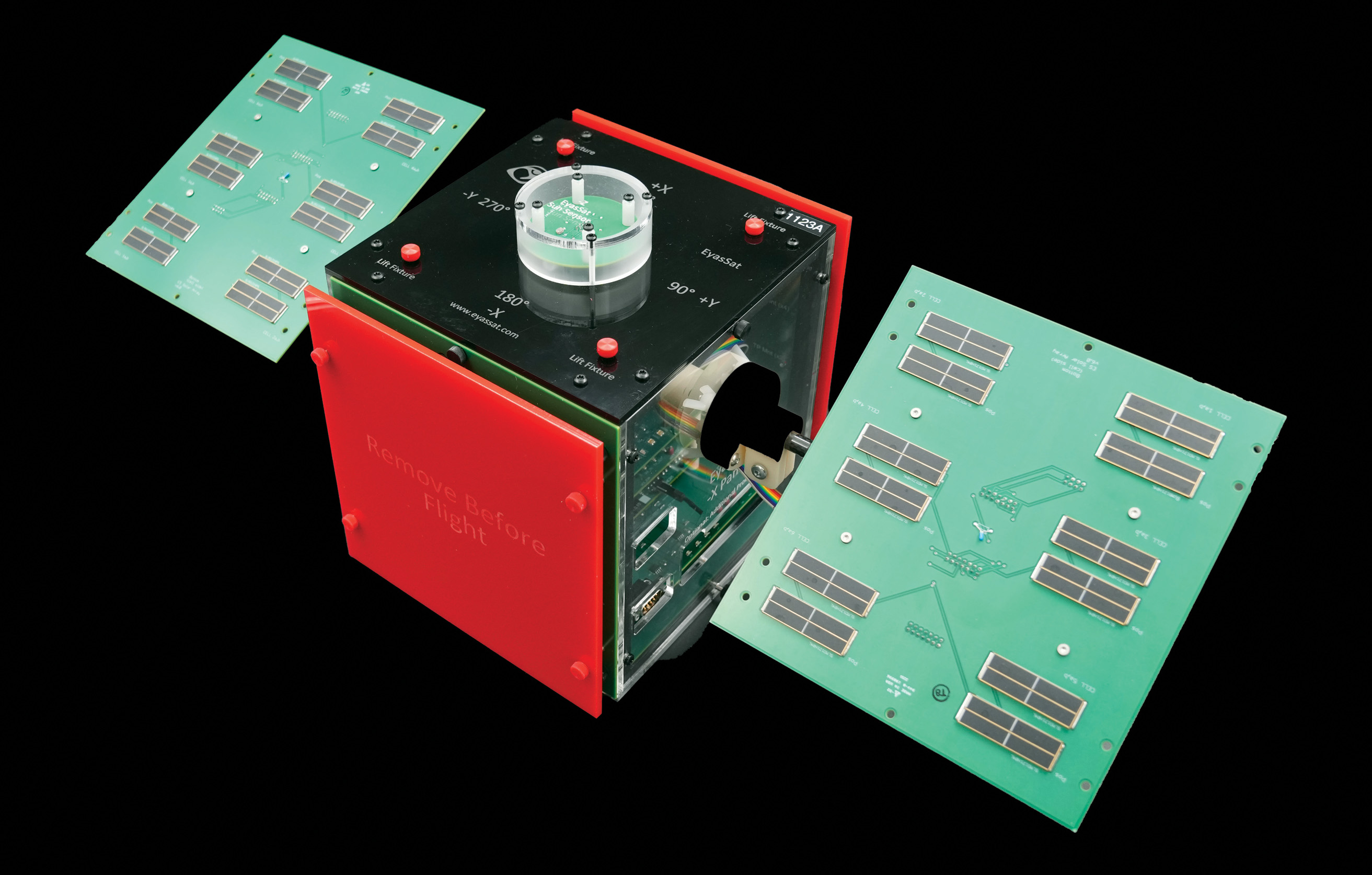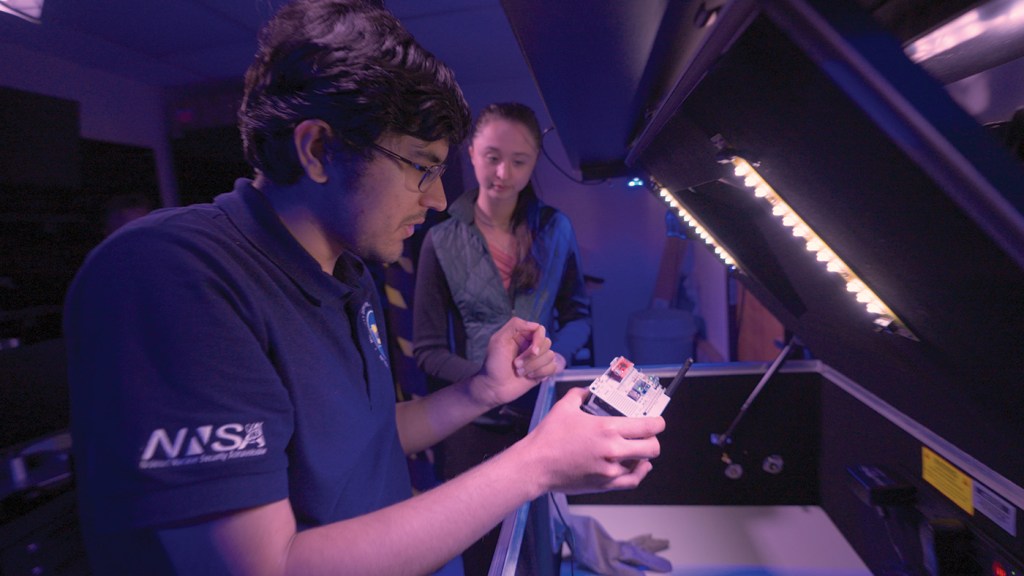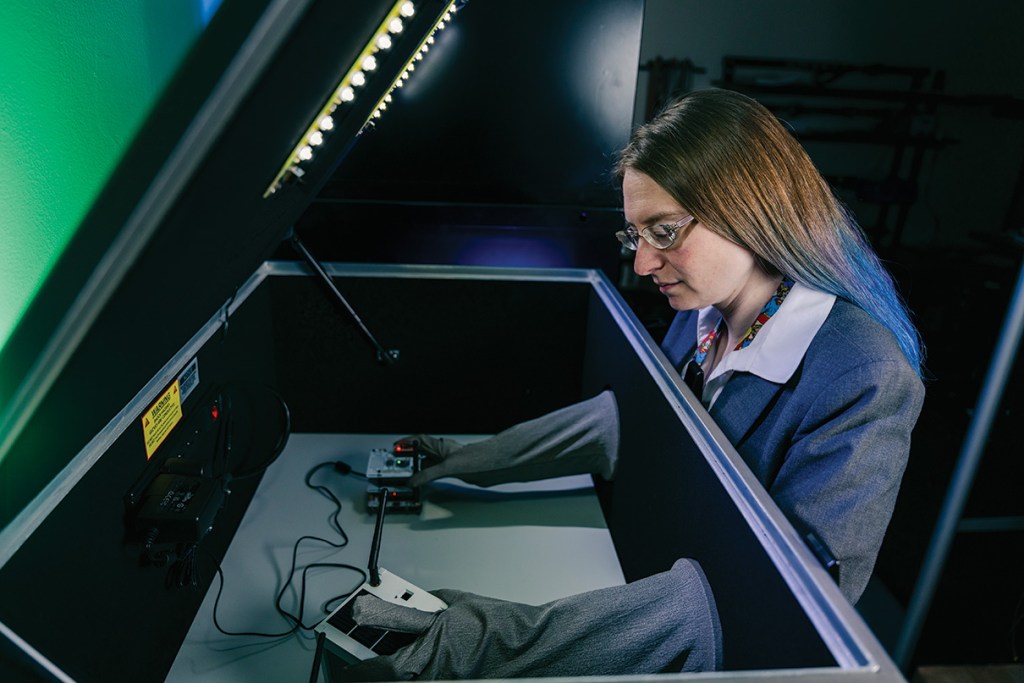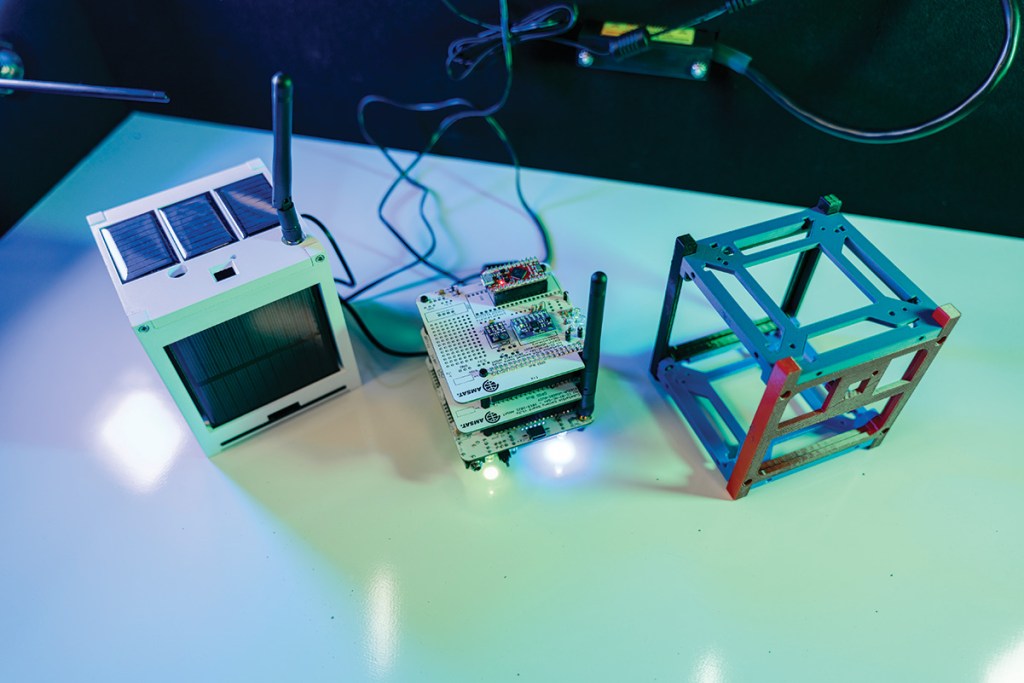“We are working to make our world a better place, and I think some of the research that my team is going to put together is really going to work toward improving tomorrow.” – Rachel Jones

EyasSat Classroom Satellite, a fully functional nanosatellite designed for teaching spacecraft systems engineering. (Alphonzo James, SRNL)
Necessity for Nuclear Power
You may know that Sputnik was the first satellite in space and that Neil Armstrong was the first man on the moon. Those facts are common knowledge for many, but the facts on another space-related milestone is not as well known: the name of the first nuclear powered satellite launched into space. While the answer is more obscure, the technology behind this bit of space trivia became an integral piece of future space exploration missions and discoveries.
When the United States Navy launched Transit 4A in June of 1961, it became the first satellite powered by a radioisotope thermoelectric generator. An RTG is one of two types of radioisotope power systems that the Department of Energy manufactures, tests, and analyzes for space exploration and security missions. The fuel that powered the RTG used for Transit 4A came from an isotope known as plutonium-238 (Pu-238). The discovery of Pu-238’s usefulness in space exploration made way for the Savannah River Site, then known as the Savannah River Plant, to put its expertise to use.
The former U.S. Atomic Energy Commission looked to SRP to produce Pu-238 for space exploration because of its extensive experience with plutonium isotopes. Scientists at the Savannah River Laboratory, now known as the Savannah River National Laboratory, referenced prior methods used with other isotopes and successfully completed its first production of Pu-238 in 1959. SRP then provided that Pu-238 to power Transit 4A’s RTG. To effectively explore deep space, missions that extend past Earth and the moon, the National Aeronautics and Space Administration must ensure that all spacecrafts and space instruments have a reliable, long-lasting power system to provide electricity and heat, and Pu-238 became vital to providing that.
RTGs produce energy by converting heat from the natural decay of Pu-238 into electricity. Pu-238 has a half-life of about 88 years, which means it would take nearly that long for just half of the Pu-238 to decay. Therefore, it can act as an energy source for decades.
The site’s Pu-238 research through SRL and production at SRP continued to be the fuel source for a number of additional missions, including NASA’s Cassini-Hyugens. The spacecraft launched in 1997, reached Saturn in 2004, and explored Saturn’s moons for more than two decades. The Pu-238 produced and provided by SRP played a critical role in its longevity. Cassini was one of the last missions that used the Pu-238 from SRP, as production concluded in the late 1980s.

SRNL Interns Ritwik Sharma and Olivia Belian work with CubeSats. (Brad Bohr, SRNS)
A New Outlook
SRNL didn’t let its important role in space research disappear with the end of Pu-238 production. Space Science and Cybersecurity Analyst Rachel Jones mentored SRNL intern Olivia Belian in 2023 during her redesigning of CubeSat structure for space research. CubeSats are essentially mini satellites that were initially created to be used in education settings for students to study spacecraft design and development. The design landed Belian’s work in the AMSAT Journal, a bi-monthly digital magazine published by the Radio Amateur Satellite Corporation. Belian is back at SRNL as an intern, advancing the lab’s research on alternative power and propulsion systems for interplanetary deep space missions with CubeSats.
NASA is now turning to CubeSats for the exploration of deep space because of the cost effectiveness, but the longevity of the current propulsion systems and electronics used for CubeSats isn’t sufficient for the lengthy type of research desired.
“The electronics have a death date of 25 years, so it is a race against time,” Belian said. “I’ve been looking at everything from batteries and solar power to things like RTGs and nuclear thermal propulsion. Long-term power solutions are essential for any exploration past Jupiter.”
Belian indicated that there has only been one interplanetary CubeSat mission to date, the Mars Cube One, or MarCo, launched by NASA’s Jet Propulsion Laboratory in 2018.
“Nuclear power is consistent, and we know it’s going to work. It is almost a necessity when having to maintain human life according to most academic literature out now,” Jones added. “[Other countries] are looking at placing nuclear reactors on the south pole of the moon, and there are other industries looking for nuclear propulsion to get us to Mars sooner.”
Although Pu-238 nuclear propulsion has traditionally been the method of choice, Jones said there are alternatives. For instance, the European Space Agency is currently gearing up to use americium-241 (Am-241) to help power its first Mars Rover, named Rosalind Franklin.
“SRNL has a great resource and ability to help drive this science for the future,” said Jones.

Space Science and Cybersecurity Analyst Rachel Jones works with the terrestrial-based satellite test bed in the space research lab at SRNL. (Brad Bohr, SRNS)
Safeguarding Satellites
In addition to deep space exploration research, Jones is using her cybersecurity expertise to drive her study of small commercial satellites. The SRNL Laboratory Directed Research and Development program is allowing Jones to make strides in her findings on satellite cyberattacks.
“My LDRD [project] looks at the data integrity of small satellites,” she said. “We’re focusing on them because there is a growing need for literature, standards, and guidance for teams who build these small satellites to build in cybersecurity – to build in assurance that they aren’t going to get hacked.”
One of her main goals is to disseminate information, communicate the vulnerabilities that exist, and lay out ways to mitigate those vulnerabilities. Jones believes that is key for small satellite success.
Jones, Belian, and another SRNL intern under Jones’ mentorship, Chase Hyman, are using a terrestrial-based satellite test bed to further the research. The STB uses a radio frequency glove box where Jones and her team can simulate cyberattacks on satellites where stored information or provided information is altered.
“We’re working to see if we can prevent hackers before they get to a certain point of intrusion through radio frequency signatures,” Hyman said. “This technology would help commercial vendors to identify attacks on their small satellites.”
Hyman is also a member of the Army National Guard where he serves as a member of the Critical Infrastructure Team of the 135th Cyber Security Company, the only such company in the Guard. His unique experience with a team that specializes in industrial control systems has proven useful in his research at SRNL.
“We really go in depth into the defense of internet connected devices, and that’s closely related to space satellites because they suffer from many of the same problems,” Hyman said.
As Jones and her team explore and uncover new knowledge about cybersecurity in space, they are confident their research will contribute to a safer planet.
“We are working to make our world a better place, and I think some of the research that my team is going to put together is really going to work toward improving tomorrow,” she said.
Hyman echoed Jones’ sentiments, adding, “The better we can inform people of what’s out there, the better security in space will be in the future.”

CubeSats like the ones pictured are being researched and restructured to aid in deep space exploration. (Brad Bohr, SRNS)
Focusing on the Future
Jones is hopeful the research will affect major change and decisions when it comes to alternative power for space missions and cybersecurity efforts in space.
“I would like us to be a supporter of future actions when it comes to space nuclear, power and propulsion,” she said. “I also want us to continue to help commercial partners and be able to provide that background and feedback for space cybersecurity. Right now, I don’t believe that other labs are looking into this issue, so if we continue in this space, we’d be one of the first national labs to provide this kind of support.”.